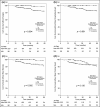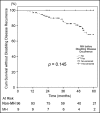Mucosal Healing Is Associated With the Reduced Disabling Disease in Crohn's Disease
- PMID: 30839440
- PMCID: PMC6445605
- DOI: 10.14309/ctg.0000000000000015
Mucosal Healing Is Associated With the Reduced Disabling Disease in Crohn's Disease
Abstract
Objectives: Mucosal healing (MH) is the goal of the "treat to target" strategy in Crohn's disease (CD), which seeks to prevent disability. However, evidence is limited regarding whether achieving MH can reduce disability in CD. We aimed to estimate the probability of disabling disease and to investigate the association between MH and disabling disease in CD.
Methods: This was a retrospective case-control study of 319 consecutive CD patients. The primary outcome was disabling disease occurrence (defined as surgery, hospitalizations, steroid dependency, or disease complications). The secondary endpoint was disabling disease recurrence. The Kaplan-Meier method and Cox proportional hazards model were used to calculate cumulative rates and for multivariate analysis, respectively.
Results: Of 319 CD patients (median follow-up time: 42.4 months, interquartile range: 24.7-60.0 months), 105 (32.9%) progressed to disabling disease and 20 (6.3%) had the recurrence of disabling disease. The cumulative rates of disabling disease were 11.3%, 30.2%, and 44.9% at 1, 3, and 5 years, respectively, after diagnosis. MH was associated with a significantly lower frequency of surgery, new penetrating event, and new stenosis (P = 0.004, P = 0.001, P = 0.002, respectively). Univariate and multivariate analyses revealed that MH was an independent protective factor of disabling disease occurrence (hazard ratio: 0.166, 95% confidence interval: 0.084-0.329).
Conclusions: Disabling disease was common in Chinese CD patients and increased during follow-up. Moreover, MH was significantly associated with a reduced occurrence of disabling disease in CD.
Figures




References
-
- Torres J, Mehandru S, Colombel JF, et al. Crohn's disease. Lancet 2017;389:1741–55. - PubMed
-
- Cosnes J, Gower Rousseau C, Seksik P, et al. Epidemiology and natural history of inflammatory bowel diseases. Gastroenterology 2011;140:1785–94.e4. - PubMed
-
- Peyrin-Biroulet L, Loftus EJ, Colombel JF, et al. The natural history of adult Crohn's disease in population-based cohorts. Am J Gastroenterol 2010;105:289–97. - PubMed
-
- Dias CC, Rodrigues PP, Coelho R, et al. Development and validation of risk matrices for Crohn’s disease outcomes in patients who underwent early therapeutic interventions. J Crohns Colitis 2017;11:445–53. - PubMed
-
- Beaugerie L, Seksik P, Nion Larmurier I, et al. Predictors of Crohn's disease. Gastroenterology 2006;130:650–6. - PubMed
Publication types
MeSH terms
Substances
LinkOut - more resources
Full Text Sources
Medical

